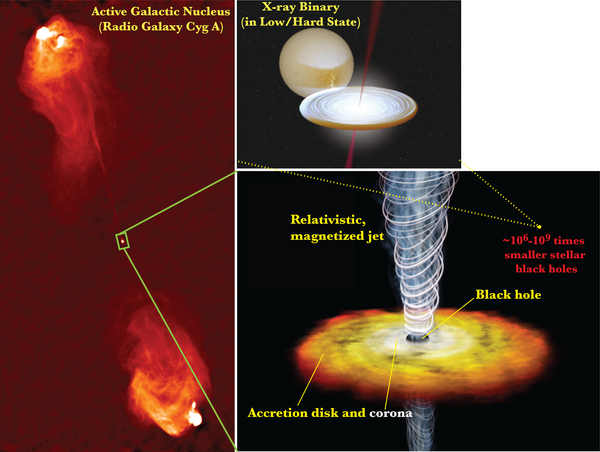|
PhD Student: Salomé Dibi-Rousselle Start Date: Jul 2009
End Date: Jun 2013 (last year funded out of non-EU sources)
Responsible Advisor: Sera Markoff (University of Amsterdam)
Co-Advisors: Phil Uttley (Southampton), Stéphane Corbel (CEA Saclay) 
Small galactic black holes (GBHs), formed when massive stars die and go supernova, are scattered throughout the galaxy. They are in general invisible, unless found in a binary with a companion star upon which they can "feed", powering several forms of luminous processes during outbursts of activity. The material gravitationally captured from the star forms a disc as it inspirals towards the event horizon, at which point some of the material is also expelled perpendicular to the disc in the form of enormous jets of plasma. Somehow these jets are accelerated up to near light speeds by mechanisms likely governed by magnetic fields, but how this works is still a big mystery in our field. Similar jets are seen in many other systems, from young stars to gamma-ray bursts, thus we are very interested in understanding why and how this occurs. We observe two different types of jets during cycles of outburst in the small black holes, one with compact but steady jets, and one with more energetic blobs of plasma ejected at very high speeds. And in some phases of a GBH outburst, jets are not detected at all. It is currently suspected that the same behavior occurs in the supermassive black holes lurking in the centers of galaxies, but on timescales millions or billions of times longer and thus not directly observable. The huge jets produced can actually change the evolution of the entire galaxy harbouring the black hole, and thus is very important to understand for models of galaxy evolution over cosmological timescales (i.e., significant compared to the age of the universe).
The aim of this project is to build a better theoretical understanding of how these jets form and are ejected from the black hole system, as well as what determines the different types of jets observed. We also aim to try to relate the behaviour directly observed in GBHs to those occurring in galactic center supermassive black holes. The PhD student will develop new theoretical models for the time-dependent behaviour of the jets, to be compared with astronomical data from the radio through gamma-ray wavebands. The modeling work will include numerical calculations using computer codes the PhD student develops, sophisticated state-of-the-art computer simulations of magnetohydrodynamics in the extreme environments near black holes, and the fitting of astronomical data from the Network and collaborators. This project will rely heavily on data obtained in the other projects in the Network. Co-advisor Dr. Stephane Corbel at CEA Saclay will help define the critical data sets for this project, and advise in their modeling and interpretation, along with co-advisor Dr. Phil Uttley at the University of Southampton. Dr. Uttley will also help advise on the results from the project which can best inform us about the exciting link between the smallest and largest black holes.
An overview talk on the current state of the project as presented at the Collaboration Meeting in September 2010 in Istanbul can be found here.
Related publicationsRefereed
- Drappeau, S., Dibi, S., Dexter, J., Markoff, S., and Fragile, P. C., 2013, Self-consistent spectra from radiative GRMHD simulations of accretion on to Sgr A*, MNRAS, 431, 2872 (ADS-Entry)
- Dibi, S., Drappeau, S., Fragile, P. C., Markoff, S., and Dexter, J., 2012, General relativistic magnetohydrodynamic simulations of accretion on to Sgr A*: how important are radiative losses?, MNRAS, 426, 1928 (ADS-Entry)
Other
- Drappeau, S., Dibi, S., Dexter, J., Markoff, S., and Fragile, P. C., 2011, Self-consistent spectra from GRMHD simulations with radiative cooling: A link to reality for Sgr A, in: Alecian, G., Belkacem, K., Samadi, R., and Valls-Gabaud, D. (ed.), , Proceedings of the Annual meeting of the French Society of Astronomy and Astrophysics, 563-565 (ADS-Entry)
- Dibi, S., Drappeau, S., Markoff, S., and Fragile, P.C., 2011, Numerical theory of accretion flow and jet launching: A study of the Galactic center, in: Romero, G., Sunyaev, R. A., and Belloni, T. M. (ed.), Jets at all scales, Proc. IAU Symposium 275, 102 (ADS-Entry)
- Drappeau, S., Dibi, S., Markoff, S., and Fragile, P.C., 2010, Self-consistent spectra from GRMHD simulations w/radiative cooling A link to reality for Sgr A*, in: Romero, G., Sunyaev, R. A., and Belloni, T. M. (ed.), Jets at all scales, Proc. IAU Symposium 275, 104 (ADS-Entry)
Fast Communications
none yet available
|



